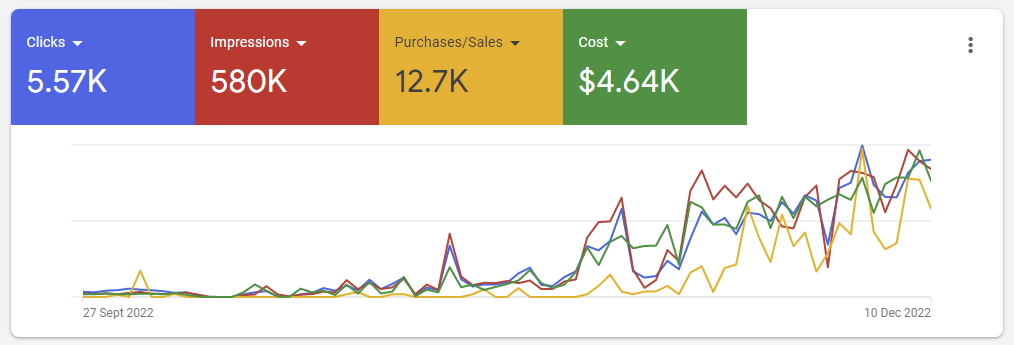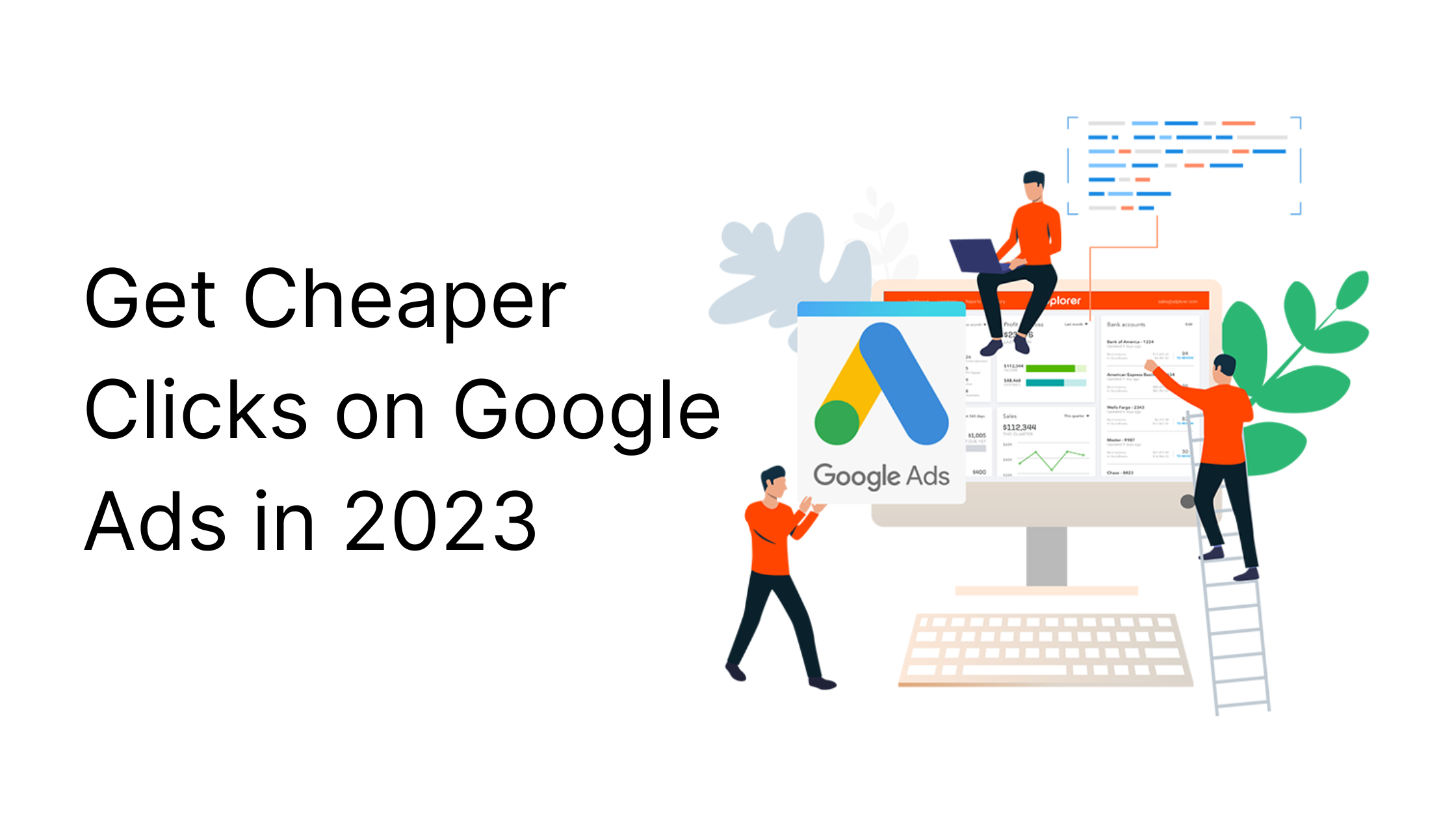Google Ads is a powerful platform that can help you reach your target audience and drive conversions. However, running an effective Google Ads campaign can be expensive, especially if you’re not using the right strategies. In this article, we’ll share 10 proven strategies to help you get cheaper clicks on Google Ads in 2023.

1. Conduct Keyword Research
Keywords are the foundation of any Google Ads campaign. Conducting thorough keyword research can help you identify the most relevant and cost-effective keywords for your campaign. Here are some tips to keep in mind:
- Use tools like Google Keyword Planner, Ahrefs, or SEMrush to identify high-volume, low-competition keywords.
- Use long-tail keywords that are more specific and less competitive.
- Consider negative keywords to exclude irrelevant search terms and reduce wasted spend.
- Continuously monitor your keyword performance and make adjustments as needed.
2. Optimize Your Ad Copy
Your ad copy is what entices users to click on your ads. Optimizing your ad copy can help improve your click-through rate (CTR) and reduce your cost per click (CPC). Here are some tips to consider:
- Include your target keyword in your ad copy and headlines.
- Highlight your unique value proposition and what sets you apart from your competitors.
- Use ad extensions like sitelinks, callouts, and reviews to provide additional information and increase the visibility of your ads.
- A/B test different ad variations to identify the most effective messaging and design.
3. Improve Your Quality Score
Google assigns a Quality Score to your keywords and ads based on their relevance and performance. A higher Quality Score can help reduce your CPC and improve your ad rank. Here are some ways to improve your Quality Score:
- Ensure your landing pages are relevant and user-friendly.
- Increase your ad relevance by using targeted keywords in your ad copy and landing pages.
- Improve your ad and landing page load times.
- Optimize your ad targeting and ad scheduling to reach the most relevant audience.
4. Use Smart Bidding Strategies
Google Ads offers several automated bidding strategies that can help you get cheaper clicks and maximize your ROI. Here are some options to consider:
- Target CPA bidding: This strategy sets your bids to help you achieve your desired cost per acquisition (CPA).
- Target ROAS bidding: This strategy sets your bids to help you achieve your desired return on ad spend (ROAS).
- Enhanced CPC bidding: This strategy adjusts your bids based on the likelihood of a conversion.
- Maximize conversions bidding: This strategy automatically sets your bids to help you get the most conversions within your budget.
5. Narrow Your Targeting
Targeting a broad audience can be expensive and inefficient. Narrowing your targeting can help you reach the most relevant audience and reduce your CPC. Here are some options to consider:
- Use geographic targeting to reach users in specific locations.
- Use demographic targeting to reach users based on age, gender, or household income.
- Use audience targeting to reach users who have previously interacted with your brand or are similar to your existing customers.
- Use device targeting to reach users on specific devices or operating systems.
6. Leverage Ad Scheduling
Ad scheduling allows you to specify when your ads will be shown to users. Leveraging ad scheduling can help you reach users at the most optimal times and reduce your CPC. Here are some tips to consider:
- Analyze your historical data to identify the most effective times
- Adjust your bids during peak hours to increase visibility and reduce competition.
- Use dayparting to adjust your bids by the day of the week or time of day.
- Consider testing different ad schedules to identify the most effective times for your audience.
7. Use Ad Placement Exclusions
Ad placement exclusions allow you to prevent your ads from showing on specific websites or placements. This can help reduce wasted spend and improve the quality of your traffic. Here are some options to consider:
- Exclude websites that are not relevant to your business or have a low-quality score.
- Exclude placements that are not performing well or have a low click-through rate.
- Exclude mobile app placements that are not relevant to your audience or have a low conversion rate.
- Continuously monitor your placements and adjust your exclusions as needed.
8. Improve Your Landing Page Experience
Your landing page experience can impact your ad performance and quality score. Improving your landing page experience can help improve your conversion rate and reduce your CPC. Here are some tips to consider:
- Ensure your landing page is relevant to your ad copy and keywords.
- Use clear and concise headlines and subheadings.
- Highlight your unique value proposition and key benefits.
- Use high-quality images and videos to showcase your products or services.
- Use clear and visible calls to action (CTAs).
9. Use Ad Customizers
Ad customizers allow you to create dynamic ads that are tailored to individual users based on their search queries or preferences. This can help improve your ad relevance and click-through rate. Here are some examples:
- Use countdown timers to create a sense of urgency and encourage users to take action.
- Use location insertions to personalize your ads based on the user’s location.
- Use keyword insertions to dynamically update your ad copy based on the user’s search query.
- Use ad customizers to create dynamic headlines, descriptions, and CTAs.
10. Monitor Your Campaign Performance
Monitoring your campaign performance is crucial to identifying areas for improvement and reducing wasted spend. Here are some metrics to track:
- Cost per click (CPC): This measures the average cost per click for your ads.
- Click-through rate (CTR): This measures the percentage of clicks compared to impressions.
- Conversion rate: This measures the percentage of users who completed a desired action.
- Quality Score: This measures the relevance and performance of your keywords and ads.
- Return on ad spend (ROAS): This measures the revenue generated compared to ad spend.
- By tracking and analyzing these metrics, you can identify areas for improvement and optimize your campaign for cheaper clicks and higher ROI.
FAQs
How can I reduce my CPC on Google Ads?
There are several strategies you can use to reduce your CPC, including conducting keyword research, optimizing your ad copy, improving your quality score, using smart bidding strategies, narrowing your targeting, leveraging ad scheduling, using ad placement exclusions, improving your landing page experience, using ad customizers, and monitoring your campaign performance.
What is Quality Score, and how does it impact my CPC?
Quality Score is a metric that measures the relevance and performance of your keywords and ads. A higher Quality Score can help reduce your CPC and improve your ad rank.
What are some common mistakes to avoid when running a Google Ads campaign?
Some common mistakes to avoid include targeting a broad audience, using irrelevant keywords, not optimizing your ad copy or landing pages, using ineffective bidding strategies, and not monitoring your campaign performance.
Google Ads can be a valuable tool for reaching your target audience and driving conversions. However, running an effective campaign requires a strategic approach and ongoing optimization.
By implementing these 10 strategies, you can reduce your CPC and improve the performance of your Google Ads campaign. Remember to conduct keyword research, optimize your ad copy, improve your quality score, use smart bidding strategies, narrow your targeting, leverage ad scheduling, use ad placement exclusions, improve your landing page experience, use ad customizers, and monitor your campaign performance.
Keep in mind that reducing your CPC should not be the only goal of your campaign. Ultimately, your focus should be on driving conversions and achieving a positive ROI. By creating relevant and high-quality ads that resonate with your audience, you can increase the effectiveness of your campaign and drive more revenue for your business.
In conclusion, reducing your CPC on Google Ads requires a combination of strategic planning, ongoing optimization, and a focus on delivering high-quality ads that meet the needs of your target audience. By implementing these 10 strategies, you can optimize your campaign and achieve more cost-effective clicks, ultimately driving more conversions and revenue for your business.


